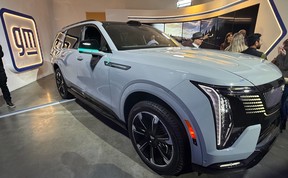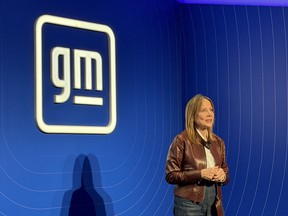‘Super Cruise’ driving will soon get a major boost to free up your time
Article content
If you’re one of the millions of Canadians who have grudgingly returned to a physical office, your twice-a-day commute may soon get a lot easier.
Advertisement 2
Article content
At its GM Forward media event in New York, attended by yours truly, General Motors announced what’s coming down the road for Super Cruise, its semi-autonomous driver-assistance system that has already logged more than 1.1 million kilometres since it debuted in 2017 (without a reported crash attributed to the technology).
Article content
Article content
In 2028, GM will bring “eyes-off” driving to select highways (to start), so you can read a book, watch a TV show, work on your laptop or chat face-to-face with whomever you’re carpooling with – all while the vehicle accelerates and decelerates, and changes lanes for you.
Compare this to today, where Super Cruise is a “hands-off” (the wheel) experience, but a camera and infrared emitters are embedded in the top of the steering column to monitor your head and eye position, to ensure you’re paying attention to the road.
Advertisement 3
Article content
This will no longer be required, says GM, with its “eyes-off” upgrade to Super Cruise within two years, beginning with the Cadillac ESCALADE IQ electric SUV.
(The eyes-off feature qualifies as “Level 3” autonomy, compared to today’s “Level 2” Super Cruise automated driving system, but the driver must remain in the driver’s seat and be prepared to take over when the system requests.)

“One of the main goals here is to give you the gift of time back, so you can use that time to be entertained or stay productive,” GM’s Senior Vice President of Software and Services Baris Cetinok explained in an interview at the NYC event. “For example, I live in the Bay Area and when I drive to a (Golden State) Warriors game from where I live, that’s a good hour drive into the city, and an hour back, and 90-plus percent of my time are highway miles – so that’s a lot of wasted time.”
Article content
Advertisement 4
Article content
Cetinok said the other goal is to provide a safer experience, thanks to several advanced cameras, sensors and artificial intelligence.
“The cameras in good weather can see up to four football fields ahead, and it looks around your vehicle, too, in 360 (degrees) – your human eyes can’t.”
“On top of that, we will layer radar, which adds the capability to see, to punch through rain and a fog and see further ahead and detect things that a human eye or even a camera might not be able to detect,” Cetinok added. “We’re also bringing LiDAR as a sensor to actually get a more precise depiction of the world, including to be able to detect trajectory and the velocity of any objects or vehicles that might be on the road.”
Read More
Advertisement 5
Article content
Not currently part of the Super Cruise system (available in 23 GM vehicles), LiDAR works by emitting laser pulses and measuring the time it takes for the light to reflect off objects and return the data to the sensor.
“If you’re driving about 70 miles an hour and you need to react quickly to something, an attentive human – that is not distracted – will take maybe 1.5 to 2 seconds,” Cetino explained. “Our goal is to continuously sense the world using multiple sensor types and 360 (degree imagery) and make those decisions in milliseconds.”
Video demos at the event showed motorcyclists cutting off drivers, and a deer prancing across a highway, as examples of what might happen on a drive.
“One thing I always repeat anytime I talk to people about how we make product choices is safety is not a feature for us – it’s a value of GM. Safety has to come first,” Cetinok said.
Advertisement 6
Article content
GM also had a futuristic Cadillac ESCALADE IQ electric SUV concept on-hand, with prominent turquoise lighting across the dashboard and side mirrors that will signal when the Super Cruise system is active – to the driver and others on the road.

Conversational AI, too
Along with autonomy, General Motors Chair and CEO Mary Barra and other senior leaders showcased automotive advancements in AI, robotics, and energy, at GM Forward.
Beginning next year, select GM vehicles will feature “conversational AI” powered by Google Gemini, making it possible to talk to your car as naturally as you would to a fellow passenger.
Then, within a few years, GM will introduce its own personalized AI, custom-built for your vehicle and connected by OnStar, the company announced. The AI will draw directly from your vehicle’s onboard intelligence to surface relevant, vehicle-specific info.
Advertisement 7
Article content
With your permission, it may offer predictive maintenance suggestions (like hearing “the air pressure in your front left tire is a little low”), or it may recommend a restaurant based on your past preferences and routes. In a video demo viewed at GM Forward, your vehicle may also understand its location, such as a driver or passenger asking “what’s the name of this bridge?” you’re currently driving across, and hearing the correct answer in a human-like voice.
GM’s BrightDrop discontinued
While features like autonomous driving and in-vehicle conversational AI are exciting, the news last week was less so: GM Canada is ending production of its BrightDrop electric delivery vans in Ingersoll, Ont., delivering another blow to the province’s automotive sector.
Advertisement 8
Article content
As reported by Postmedia, GM Canada says the decision is related to low demand for the model and other related factors – likely changing regulations and the loss of key U.S. EV (electric vehicle) tax credits.
GM’s current production facilities in Ontario remain in Oshawa, which builds Chevrolet Silverado pickup trucks, and some assembly of parts, and its St. Catharines Propulsion Plant, which builds engines for select trucks and SUVs. The company also employs engineers, developers and other technical experts across three Ontario locations, including a 150,000-sq.-ft. engineering facility in Markham that opened in 2018.
And GM and POSCO Future M are still committed to building a facility in Bécancour, Que. to produce materials for GM’s EV battery cells.
– Marc Saltzman is the host of the Tech It Out podcast and the author of the book Apple Watch For Dummies (Wiley).
Article content


